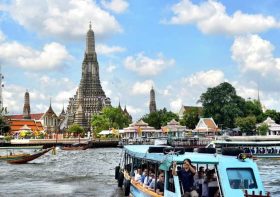Elephant Nature Park in Thailand: Voluntourism at Its Best


It’s easy to admonish digital travel content as too vapid or insincere and, honestly, a lot of it deserves those criticisms. But to brush an entire medium with one broad stroke is irresponsible, and there are many bloggers out there creating some wonderful stories and sharing information that needs to see the light of day. One of those stories is about a special reserve in Northern Thailand. I first learned of it a few years ago when another blogger was working there. Ever since I’ve been obsessed with the idea of visiting myself and participating in this unique voluntourism experience. I had that chance a few months ago when I returned to Thailand, one of my favorite countries, and decided to spend some time in a city that was new to me – Chiang Mai. Long serving as the home base for many an intrepid traveler into the region’s Golden Triangle, it was my home base as well, but for a very different experience, spending the day at the Elephant Nature Park.

Why I Felt the Need to Volunteer
It’s hard to write about my lapses in judgment, and I do so with more than one tear in my eye, but it’s important I think to show how I have erred so that others can avoid feeling as I do. On my first trip to Thailand I spent several days on the tropical island of Koh Samui. A large private suite at a luxury hotel, fruity drinks with umbrellas and a gorgeous beach – these were the main reasons why I wanted to visit this famous island retreat. I also decided to try an excursion one afternoon, riding an elephant. All I can say now is that I was young and stupid, relatively inexperienced in the world of travel and naïve when it came to understanding the ramifications of my travel decisions. Given my natural love of animals I feel drawn to them when I travel, and I stupidly signed up for an elephant encounter. That ‘encounter’ involved riding around on top of these beautiful animals in the middle of the jungle. The thing is, as soon as I arrived I knew it was wrong and after sitting on top of that poor elephant I instantly sensed his sadness. Just looking into his eyes I saw a misery and pain that I never want to see again. I left the site immediately, seething from anger and frustration. I was angry at myself for not knowing better and frustrated at my own inability to affect change on any level. Even today I tear up thinking about that poor elephant and the excursion; it touched me that deeply. It’s for elephants like that one in Koh Samui that the Elephant Nature Park (ENP) exists.

What is the Elephant Nature Park?
Established in the 1990s, the park is a sanctuary and rescue center for elephants from around the region. They rescue elephants from the tourism industry and give them a place to live where they are not chained, do not perform or work for people and instead get to live as close to the wild as they can, while being observed and fed/bathed by tourists. Although elephants are trained at these facilities, it is only so they can receive medical treatments, and training is done with positive reinforcement and never pain. Mahouts at ENP are not allowed to use bull hooks or other instruments to get their elephants to listen to them.
There isn’t one specific issue as it relates to elephants and tourism activities around the world. There are quite a few, which makes elephant tourism a very tricky subject. The first thing people need to know about elephant tourism is that the elephants they see in the trekking camps, the circuses, the painting classes … they have all gone through an abusive and torturous process to break their spirit. Every elephant that is captive has been put through a process called “the Crush.” In Thailand, it is known as the “phajaan” and throughout Southeast Asia it has different names, depending on the country. This breaking of the spirit involves a young elephant, often times captured from the wild and his or her family slaughtered, who is then confined to a small wooden corral for about a week. During this time, the elephant is shackled or tied (all legs) so the animal cannot move, and then ritually beaten with bamboo topped with nails, bludgeoned with bull hooks, deprived of food and water and taught basic commands. At the end of this process, the elephant is said to be “broken” and no longer has bonds to the family – which is incredibly strong in the wild. Sadly, that is only the beginning of a life of pain and misery. It is from this painful life that the ENP rescues the elephants and gives them the opportunity to live life as they were meant to.

A Day With the Elephants
As a true lover of wildlife and a fervent conservationist, I was excited to spend the day at the Elephant Nature Park. They offer a number of different options for would-be volunteers, including living there for a few days for a more immersive experience. Most visitors do what I did though, elect to spend the day at the reserve which is about an hour’s drive from Chiang Mai. We were picked up that morning from our Chiang Mai hotel, the 137 Pillars House, excited for the day ahead. Along the way a video in the van played, outlining the problem facing Thailand’s elephants and how the Elephant Nature Park strives to help as many as they can. Arriving to the park it was organized chaos. Dozens upon dozens of vans were already there, packed with visitors from all over Northern Thailand, everyone there for the same reason – to spend a day helping the elephants.
As I soon learned though, the program at the Elephant Nature Park is a very well oiled machine. We started off by feeding some herd members as they wandered by the viewing platform; a mix of fruits they seemed to love. It’s important to note that the Park doesn’t only rescue elephants, there are many different animals around the property, all rescued, including many dogs. As a dog owner, I naturally gravitated towards these rescued pups that obviously were used to a lot of attention. The day with the elephants seemed to fly by. With our guide and leader for the day, we trekked out into the property for a better look at the beautiful and graceful elephants, learning their stories and seeing a light of hope and optimism in their eyes. It was shocking to hear how very badly many were treated in their former lives. I just can’t believe people would hurt another living creature in such vile ways. After a large country-style Thai lunch, we walked down to the river for what is the highlight of the day for many visitors, elephant bathing. Getting more water on myself than the elephants, it was a fun way to learn even more about the elephants while helping in a very small way. Overall, the experience at the Park isn’t really about the limited help day visitors offer. It’s about both educating people as they spend the day with the elephants and the fees paid to the Park that are used to rescue even more elephants. I was very happy to contribute in a small but hopefully meaningful way. It was important for me to be there and to learn more about what we as tourists can do to help and not harm the places we visit.

Responsibility as Tourists
When looking for responsible wildlife tourism options, it is important to keep in mind whether or not these facilities are actually sanctuaries or not. If they offer rides, shows, performances and so on, this is a big red flag. These facilities may “rescue” the elephant, but the life the elephant lives still is not ideal and would fall under irresponsible tourism for those who decide to visit.
Just as hikers and campers venture into the wilderness with a pledge to leave it untouched, the same must be true for travelers wherever we go. Sustainable and responsible tourism are so much more than slogans or nice things to say. To travel mindfully is how we must all travel if we want to stop the abuse happening around the world not only to elephants, but animals of all types. These activities persist because of us. If we stopped buying tickets or patronizing the companies, they would no longer offer the activities. It is a slow and deliberative process, no doubt there, but it’s an important one. We as tourists are responsible for the reprehensible acts being committed to thousands of animals around the world. It simply has to stop so that future generations of elephants can live happily and we as human beings can live with ourselves.
The post Elephant Nature Park in Thailand: Voluntourism at Its Best appeared first on LandLopers.



Leave a Reply